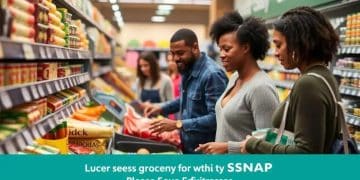Supplemental Nutrition Assistance Program (SNAP) restrictions explained
Anúncios
The Supplemental Nutrition Assistance Program (SNAP) provides essential benefits to help individuals and families purchase eligible nutritious food items, encouraging healthier eating while navigating specific application processes and restrictions.
Supplemental Nutrition Assistance Program (SNAP) restrictions can be complex and confusing. Have you ever wondered what you can and cannot buy with SNAP benefits? In this article, we’ll break down the key aspects of these restrictions to help you get the most from the program.
Understanding SNAP benefits
Understanding SNAP benefits is crucial for anyone looking to utilize this program effectively. SNAP, or the Supplemental Nutrition Assistance Program, helps millions of Americans access nutritious food. But what exactly do these benefits entail?
What are SNAP benefits?
SNAP benefits provide eligible individuals and families with funds to purchase food. These benefits are loaded onto a card, similar to a debit card, making it easy to shop at participating retailers.
Eligibility for SNAP benefits
To qualify for SNAP benefits, applicants must meet certain income and resource guidelines.
-
💵 Household income is considered, including wages, social security, and other sources.
-
🏠 Assets, such as savings and property, may also affect eligibility.
-
🇺🇸 Citizenship status is another important factor that determines eligibility.
It’s essential to check if you meet these criteria before applying.
Once you receive your SNAP benefits, you can buy a variety of foods, from fruits and vegetables to grains and dairy products. However, some items are not eligible, which can be confusing. Common restrictions include non-food items and certain types of prepared meals.
Understanding how to navigate these restrictions can help you maximize your benefits and enhance your shopping experience.
What can you purchase with SNAP benefits?
- Fruits and vegetables
- Meat, poultry, and fish
- Dairy products
- Bread and cereals
This variety allows recipients to maintain a balanced diet while using their benefits. Knowing what is eligible empowers you to make better food choices within the program.
Items eligible for SNAP assistance

Items eligible for SNAP assistance can make a significant difference in the lives of those who rely on this essential program. Understanding what you can buy helps maximize the benefits you receive.
Food categories that qualify
Through SNAP, you can purchase various healthy food options. This ensures that recipients can maintain a balanced diet. Below are some categories of eligible items:
-
🍎 Fruits and vegetables
-
🍗 Meat, poultry, and fish
-
🧀 Dairy products
-
🍞 Bread and cereals
These items are crucial for a nutritious diet and are readily available in most grocery stores.
Specific food items
Along with broad categories, several specific items are eligible under SNAP. For example, fresh produce like apples, carrots, and spinach can be bought with your benefits. Not only that, but you can also purchase frozen fruits and vegetables that do not contain added sugars or fats.
However, items such as prepared meals and non-food products are not allowed. Understanding these restrictions helps you shop wisely.
Special dietary needs
If you or your family members have specific dietary needs, SNAP accommodates this as well. You can purchase gluten-free products, organic items, and even baby food. It’s essential to read the labels to ensure the items are eligible.
These options allow flexibility and inclusivity for various dietary requirements, so everyone can benefit from the program.
Always check for updated lists of eligible items, as they may change. Utilizing available resources ensures you make the most of your SNAP assistance.
Common misconceptions about SNAP restrictions
Many people have common misconceptions about SNAP restrictions that can lead to confusion. It’s important to clear up these misunderstandings to ensure that everyone can benefit from the program effectively.
Myth: You can only buy junk food with SNAP
One prevalent myth is that SNAP benefits only cover unhealthy food options. In reality, recipients can purchase a wide range of nutritious items. SNAP covers fruits, vegetables, whole grains, and lean proteins.
Myth: Prepared meals are eligible
Another common misconception is that recipients can use SNAP to buy any prepared meal. However, that is not the case. Meals prepared for immediate consumption, such as restaurant food, are typically ineligible. SNAP is designed to foster healthy eating by encouraging fresh, unprocessed foods.
Myth: You can’t buy organic products
Some people believe that SNAP benefits cannot be used for organic products. This is not true! Organic fruits, vegetables, and other items are eligible for purchase, as long as they meet the program’s guidelines.
Understanding these misconceptions can empower individuals to make informed decisions using their SNAP benefits. Awareness of what is truly eligible helps maximize nutritional choices and supports healthier lifestyles.
It’s vital to stay updated and informed about what SNAP can and cannot provide. Clearing up misconceptions helps everyone better utilize the resources available to them.
Impact of SNAP restrictions on families

The impact of SNAP restrictions on families can be significant and far-reaching. These restrictions are designed to guide spending and encourage healthy eating, but they can also create challenges for households relying on the program.
Financial limitations
One major impact is financial strain. Many families find that the restrictions limit their ability to purchase certain items that may be essential for their dietary needs. This can lead to meal planning challenges, especially for larger families.
Health and nutrition
On the other hand, SNAP restrictions encourage families to select healthier options. Since junk food and sugary drinks are often ineligible for purchase, families are motivated to buy fruits, vegetables, and whole grains. This can improve overall health outcomes when the benefits are used wisely.
Food security issues
Another aspect of the impact is food security. Some families may find themselves struggling to put together nutritious meals within the confines of SNAP restrictions. This can lead to stress and anxiety about food availability.
Understanding these impacts is crucial for families to navigate the SNAP program effectively. Knowledge of what can be purchased helps in meal planning and ensures that families can maintain a balanced diet despite restrictions. By staying informed, families can make better choices and maximize their benefits.
Ultimately, the way families adapt to these restrictions has a lasting influence on their health, finances, and overall well-being.
How to navigate SNAP application process
Navigating the SNAP application process can seem overwhelming, but understanding the steps can make it much easier. This program is an essential resource for many families, and knowing how to apply correctly is crucial.
Gather your information
Before starting the application, collect all necessary documents. This includes proof of income, identification, and residency. Having your documents ready will help you fill out the application without delays.
Online application
Many states offer online applications for SNAP. Visit your state’s SNAP website to access the application form. Fill it out carefully, ensuring all information is accurate. Double-check for errors that could delay processing.
In-person application
If you prefer to apply in person, locate your nearest SNAP office. Bring all necessary documents and ask for assistance if needed. This can be a great option if you have questions.
Interview process
After submitting your application, you’ll likely be required to attend an interview. This is typically a short meeting to verify your information. Be honest and provide any additional documentation requested.
Check your status
After your interview, you can check the status of your application online or by calling your local office. It’s essential to stay updated on your application to ensure you receive your benefits promptly.
Once approved, familiarize yourself with the guidelines of using your SNAP benefits to make the most out of the program.
Tips for maximizing your SNAP benefits

Maximizing your SNAP benefits is crucial for making the most of the resources available to you. With a few smart strategies, you can stretch your benefits further and ensure your family has access to nutritious food.
Plan your meals
Meal planning is an effective way to use your SNAP benefits wisely. By creating a weekly meal schedule, you can buy only what you need. This cuts down on waste and helps you avoid impulse purchases.
Shop sales and use coupons
Take advantage of sales and promotions at your local grocery store. Look for coupons that match your planned meals to save even more. When shopping, consider these options:
- Store brand products that are often cheaper.
- Buying in bulk for non-perishable items.
- Choosing seasonal fruits and vegetables since they are typically less expensive.
Use SNAP-friendly stores
Not all stores are equal when it comes to prices. Research stores in your area that offer the best deals for SNAP users. Farmers’ markets are great for fresh produce, and some accept SNAP benefits, allowing you to get healthy options.
Track your spending
Keep an eye on how much you spend each month. Review your purchases to identify patterns. Are you buying items you don’t use? Understanding where your money goes can help you make better decisions in the future.
By implementing these tips, you can ensure that your SNAP benefits go further while providing healthy food for your family.
FAQ – Frequently Asked Questions About SNAP Benefits
What are SNAP benefits?
SNAP benefits are funds provided by the Supplemental Nutrition Assistance Program to help individuals and families purchase nutritious food.
How can I apply for SNAP benefits?
You can apply for SNAP benefits online through your state’s SNAP website or in person at your local SNAP office.
What items can I buy with SNAP benefits?
SNAP benefits can be used to purchase a variety of food items, including fruits, vegetables, meats, dairy products, and bread. Some prepared foods and non-food items are not eligible.
How can I maximize my SNAP benefits?
To maximize your SNAP benefits, plan your meals, shop sales, use coupons, and track your spending. This helps you make informed choices and stretch your budget.






